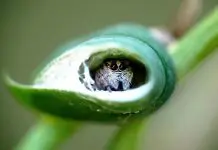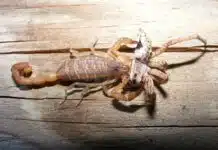While most snakes reproduce sexually, some reproduce asexually. It depends on the species. When snakes reproduce sexually, the male snake inserts his hemipenes into the female’s cloaca to fertilize the eggs.
If you are curious about snake reproduction, there is a lot to learn. Maybe you want to breed snakes or to hatch snake eggs on your own. Snake reproduction is a fascinating topic. When you learn about snake reproduction, you will be able to understand your pet snake better.
This article will answer all of your questions about snake mating, egg-laying, and how to tell male and female snakes apart. It will also explain how to breed your snakes together and raise the babies.
Learning About Snakes
There are over 3,000 species of snakes in the wild. These snakes live on every continent except Antarctica. They can adapt to a wide variety of habitats.
Most of the time, snakes prefer a solitary existence, eating every 1 to 2 weeks and only interacting with other snakes during breeding time.
With careful socialization, a snake can make a satisfying pet.
Some snake species take to being kept as pets better than others. Some species that make good pets are ball pythons, boas, garter snakes, and corn snakes. If you do your research, you can find the right snake breed for you.
Are snakes asexual or sexual?
Most snakes are born as a result of sexual reproduction, meaning that the two-parent snakes mate. The male snake fertilizes the female’s eggs using his hemipenes.
You may be surprised to learn that many types of snakes have been known to reproduce asexually. This may happen because a snake was not able to find a male to fertilize her eggs.
Scientists used to believe that asexual reproduction or parthenogenesis was rare among snakes, but they have begun to find evidence of this type of reproduction in more types of snakes than they expected.
The pit viper, copperhead, some species of boa constrictors, water snakes, and cottonmouths have all given birth asexually. The brahminy blind snake, a native of Africa and Asia, is the only known snake species that must reproduce asexually.
How do snakes reproduce?
Most snakes are born as a result of sexual reproduction. Some snakes are able to perform parthenogenesis, which is a form of asexual reproduction. In parthenogenesis, the female snake uses her own genetic material to fertilize her eggs.
A snake is sexually mature, or ready to mate, between 2 and 3 years old. Some species like the Burmese python are not able to mate until they are 4 or 5 years old. Some snakes, like the black rat snake, take even longer to sexually mature. Black rat snakes are not ready to reproduce until they are 7 to 10 years old.
Snake mating season is in the spring and summer. The reason that they cannot mate in the wintertime is that they are cold-blooded and would not be able to keep their eggs warm enough to hatch. Most snakes hibernate in the winter due to their cold-blooded bodies. In southern climates, they go into a period of reduced activity but they do not fully hibernate. When they come out of hibernation or reach normal activity levels in the spring, they are ready to mate.
In tropical conditions, snakes can breed year-round. If a snake does not have enough food or if the weather is too cold, they may not want to breed.
Frequently, snakes such as the garter snake gather in “mating balls” in the spring. This means that all of the adult snakes in the area are gathered in one place and compete to mate with the mature females. If you come across this happening in the wild, you will be fascinated. Many people who do not like snakes have fears about seeing something like a mating ball.
Occasionally snake fight to get the female’s attention. In the mating ball, dozens of snakes wrap themselves around the female snake in order to mate with her. Some snakes can be aggressive with each other as well while they are preparing to mate. The male snake will not give up on mating with the female until there is no chance of success.
Some snakes mate once a year, and others mate every 2 to 3 years. For young snakes, the mortality rate is high. This means that snakes lay many eggs in hopes that a few of them will survive.
Snakes do not keep in contact with their mates beyond the act of copulation. They are solitary animals and do not behave socially except at mating time.
How do snakes get pregnant?
You might be curious about the snake mating process. When female snakes are prepared to mate, they release a trail of pheromones to attract male snakes. When a sexually mature male snake finds this trail, he will follow it and find her.
Snake courtship happens when the male snake puts his chin on the back of the female snake’s head and crawls on her. If she is willing to mate, she lifts her tail. The male and female snake wrap themselves together so that their cloacas are lined up.
When snakes mate, the male snake extends his hemipenes, two organs that come out of the cloaca, and fertilizes the eggs inside the female. The female snake and the male snake may stay joined for as long as one day, though it is usually over in about an hour.
Some snakes, like green anacondas, have spurs on their hemipenes that encourage the female to mate. The shape of the hemipenes may match up with the female’s body in an effort to discourage males from different species from mating with the female. Green anaconda females, like other snakes, generally mate with the largest and strongest male.
You may be curious about why snakes have two hemipenes. Each hemipenes is connected to a different testicle. This means that snakes may be able to alternate the sides they use in an effort to use as many sperm cells as possible.
After mating, the eggs need to develop in the female. In the snake’s oviduct, the shells develop around the fertilized eggs. The female snake’s body makes secretions to coat the egg and form the shell. Fibers from the female’s uterus create the egg. Pregnant snakes generally take about a month to lay their eggs.
The female snake lays her eggs in a shallow nest. Mucus sticks the eggs together so that they will not roll out of the nest. Snake eggs are very soft and leathery when they are laid, but they soon toughen up. Most snake species leave their eggs right after they are laid, leaving the baby snakes to grow up on their own. They have all the instincts they need to survive.
About 70 percent of snake species are egg layers, and the remaining 30 percent give birth to live babies. Two of the most common species that have live births are garter snakes and boa constrictors. In some cases, the eggs fully develop inside the female and hatch inside her, and in some cases, the eggshells do not form at all. If your snake is a livebearer, make sure that you take her out of the enclosure right away when the babies are born. Female snakes frequently eat some of their babies if they are not removed from the enclosure.
Only one species of snake stays with its babies after they hatch. The African rock python (Python sebae) circles the nest and protects its babies from predators. The female watches out for the baby snakes for about two weeks and then leaves them to grow up on their own.
The number of eggs a snake can lay is between one and 100. Usually, they lay about 30 eggs. Not all of these eggs will hatch into baby snakes. The number of baby snakes that hatch depends on whether they are fertilized. It also depends on whether the nest is the right temperature.
The Snake Reproductive System
It is difficult to tell a male snake apart from a female snake because they have no external sex organs. Snake reproductive organs are inside the cloaca, an opening at the end of the tail. The cloaca is a dual-purpose organ that allows waste to leave the body. It is also used for reproduction. Birds and other reptiles are built in the same way.
The male snake’s reproductive system consists of two hemipenes and the testes. The hemipenes are kept in the cloaca except during mating. The hemipenes may help hold the female in place during mating.
The testes are the organs where sperm develops. A male snake has elongated, light-colored testes. They have most of the same parts as mammal testes, with seminiferous tubules to form the sperm cells. When male snake mates, these cells are released from the testes and travel through the urinary system to the hemipenes. Then the sperm is ejected from the hemipenes and travel into the female snake’s cloaca.
The female snake has a more complex reproductive system since she needs to lay the eggs. Most of the action happens within the cloaca and the oviduct. When the male releases sperm into the female, the sperm travels up the cloaca into the oviduct. The ovaries have already produced the unfertilized eggs. The sperm fertilizes the eggs and then the eggs move from the ovary to the oviduct where the shell is developed.
How do you identify male and female snakes?
It is tricky to tell which snakes are male and which are female since they have no external reproductive organs. Female snakes are usually larger than male snakes. Male snakes have thicker tails than females. It is hard to tell snakes apart from these characteristics unless you have a male and a female to compare. A veterinarian or expert reptile keeper can tell male and female snakes apart by inserting a lubricated metal rod called a snake probe into the cloaca.
When the probe is inserted, it will drop in at the length of about one to three scales. This is because the female snake does not have a hemipenes. In a male snake, the probe will drop at the length of nine to fifteen scales.
If you are not an experienced snake keeper, it is a good idea to let a veterinarian or an expert breeder sex your snakes for you. Otherwise, you could hurt them.
Can different snake species mate?
Yes, it is possible to crossbreed many different types of snakes. This can happen when the snakes are closely related, as in the corn snake and the king snake. Other types of snakes which can interbreed are different varieties of python, rat snakes, milk snakes, and gopher snakes. Garter snake subtypes are often interbred.
Some of the most popular crossbred snakes are “creamsicle corns.” These are products of the Great Plains Rat Snake and the corn snake. They have a light orange and white coloration like a Creamsicle.
You may be interested to learn that when crossbred snakes are born, they are fertile and can produce young of their own. This is not the case with many other hybrid animals such as the mule (the offspring of a female horse and a male donkey). Scientists have theories that these different varieties of snake are more closely related than anyone suspected.
You may want to crossbreed your snakes so that you can see a variety of scale patterns and colors. Crossbreeding snakes like pythons and garter snakes produces a nice range of hybrids.
If you want to crossbreed a snake, first you should put two snakes of the same breed in the enclosure together. When the male snake has begun courtship behavior, quickly replace the female snake with the species you want to crossbreed. Captive snakes may crossbreed on their own, but it is more common that you will have to switch them out.
Many reptile keepers discourage breeders from crossbreeding snakes because it has a large impact on the gene pool. If crossbred snakes are mistaken for snakes of the parent’s species, they may be used in breeding programs and produce the wrong kind of snake.
How do you breed snakes?
First, you need to find out whether your snakes are males or females. As you read above, a vet or a reptile keeper with a lot of experience needs to do this for you, or you might injure your snakes.
To prepare your snakes to breed, first you need to make sure that the enclosure has the right heat levels. Keeping the heat between 85 degrees to 100 degrees Fahrenheit will produce the best results. Don’t handle your snake after it has fed or it might regurgitate its food.
Many different types of snakes need a hibernation chamber to breed successfully. Cold-weather snakes may especially need to hibernate before they will breed. This mimics the conditions under which snakes breed in the wild. A hibernation chamber should be kept at an even temperature between 55 and 60 degrees Fahrenheit.
To prepare your female snake to breed, first you should give the snake warm baths each day. This will help the snake to clean waste from its body. Every day, lower the temperature of these baths by a few degrees. Make sure that the water is the same temperature as the hibernation chamber when you are done with the process.
Put your snake in the hibernation chamber and wait for about eight weeks. Make sure to give her water and replenish it each day. After eight weeks, gradually increase the temperature in the hibernation chamber. When the temperature has come up to the same as the regular cage, you can move her back.
Now is the time to introduce your male and female snakes. If your female snake lies down near the male snake and seems relaxed, she may be ready for mating. Keep reintroducing your snakes daily until the female loses interest. She should be producing eggs by this point.
It usually takes between 28 and 45 days for the eggs to develop inside the female, then they are laid in a nest. You can either keep or sell your baby snakes.
Some snake species can hold sperm inside themselves for up to five years. The female snake has the ability to decide whether it is the best time to be pregnant and lay eggs. If the conditions are not right, the female may hang onto the sperm and use it later on.
Hatching Baby Snakes
It is often important to move the female snake out of the enclosure with the eggs. Sometimes snakes will eat their eggs, and they will probably try to eat the newly hatched babies as well. If you want your eggs to hatch, you need to use an incubator.
You can buy an incubator online or from a reputable breeder. You can also make your own incubator using a plastic box and a Styrofoam cooler with heaters. It is easy to find directions on how to do this online.
Place your incubator in a room where the temperature will stay constant. Unlike bird eggs, do not turn your reptile eggs in the incubator. If you are using a chick incubator, make sure that you can shut the turning function off. Also, do not use a fan in the incubator because the eggs may get dehydrated.
Incubators with water baths may be the best choice for snake eggs. A water bath will provide even humidity and heat distribution. You can make a water bath by hanging an opaque plastic box holding the eggs in a water bath. You can also put a dish of water in the incubator to keep the eggs from drying out.
You should keep your incubator between 82 to 88 degrees Fahrenheit. If you have python eggs, they prefer slightly higher temperatures between 85 to 88 degrees. If you have your incubator set too low or too high, you could produce birth defects and fetal deaths.
Keeping Baby Snakes
Now that you have baby snakes, you will want to know how to care for them. Taking care of baby snakes can be challenging, as they will not want to eat right away. Baby snakes often have enough food reserves inside them from the yolk to last several weeks.
If you want to have baby snakes, you need to be prepared to feed them. Many people will find the process of feeding any snake to be disturbing. You will need to feed your baby snake very small foods, like “pinkie” mice. A “pinkie” mouse is one to two days old. For smaller species, you may need to cut these mice in half.
Some snake species are reptile eaters in the wild. These include the milk snake and king snake. In this case, you may need to “scent” your pinkie mice with a lizard skin. This may trick the baby snake into thinking it has a lizard to eat.
Before you sell or give away your baby snakes, make sure that they are eating on their own. If they are not eating on their own, their new owner may have difficulties keeping them alive.
Snake Reproduction
In this article, we have covered the basics of snake reproduction. Snakes’ mating habits and reproductive systems have been discussed, along with the egg-laying process and how to crossbreed snakes. Breeding your own snakes can be challenging, but it is a good way to see some crossbreeds that you would not see in the wild.
When you are getting ready to buy a snake for a pet, it pays to understand everything you can about it. Knowing about a snake’s reproductive system and mating habits will help you recognize when your snakes are ready to be bred.



![Sick Axolotl, Fungus, Stress Symptoms [Axolotl Illness Guide 2025] Axolotl fungus](https://exopetguides.com/wp-content/uploads/2018/06/axolotl-218x150.jpg.webp)
















